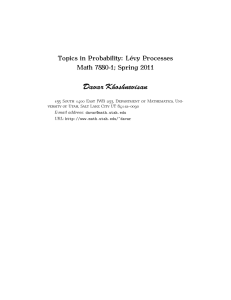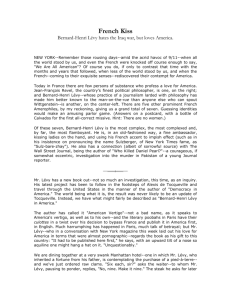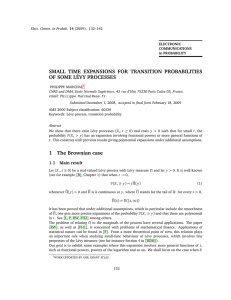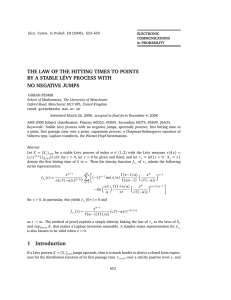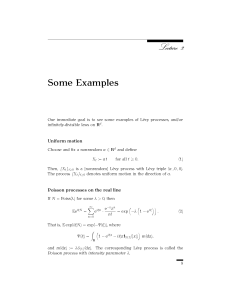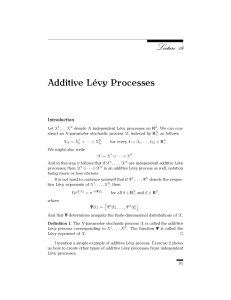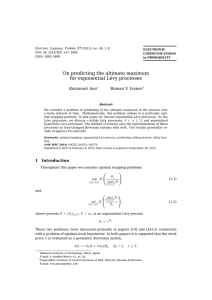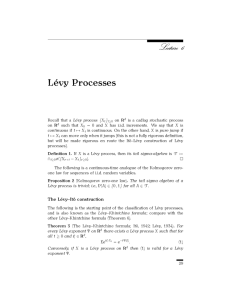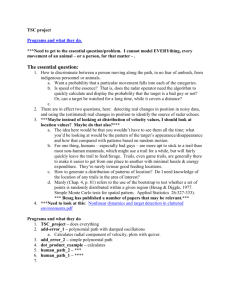On Diffusion Processes, Lévy Flights, and Confusion Cécile
advertisement
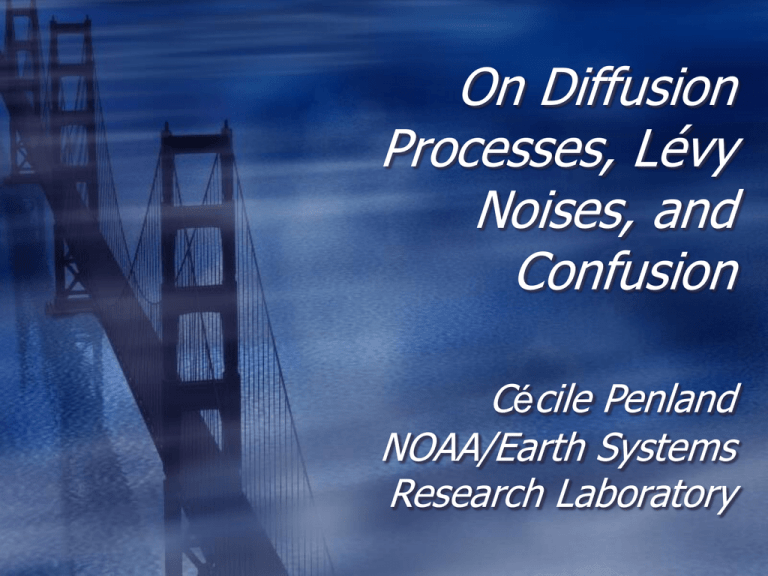
On Diffusion Processes, Lévy Noises, and Confusion Cécile Penland NOAA/Earth Systems Research Laboratory How do we model unresolved variability? •Diffusion approximation? •Lévy-driven processes? Better representation of tails? •Does our experience with diffusion processes transfer to (white) Lévy-driven processes? The diffusion approximation: dx/dt = e2 G(x,t) + e F(x,t) e2 G(x,t) is slow e F(x,t) is fast Choose a scaling s = e2t: dx G(x,s/ e 2) 1 F(x,s/ e 2) . e ds (*) For simplicity, say Fi (x, s/ e 2 ) F k (x, s)k (s/ e 2 ) and i k Ckm k (t)m (t ' t) dt ' (T )km Lim (*) -> dx G(x,s) ds + F k (x,s)k dW t->∞ e->0 k , (W is a Brownian motion; dW N(0,dt)). The Good: • Have a systematic way of handling a lot of multiscale processes. • Rigorous connection between dynamics (PDEs) and probabilistic description. dx G(x,s) ds + F k (x,s)k dW k , implies a Stratonovich Fokker-Planck eqn. The Bad: • Existence of multiple calculi can make numerical generation difficult. • The difference between Ito and Stratonovich integrals is physically-based; a thermometer will not perform the Ito correction for you. • Mathematically, it’s an issue of who speaks first: the continuum limit or the white-noise limit. NWS operational GCM (1993 version) QuickTime™ and a TIFF (Uncompressed) decompressor are needed to see this picture. QuickTime™ and a TIFF (Uncompressed) decompressor are needed to see this picture. QuickTime™ and a TIFF (Uncompressed) decompressor are needed to see this picture. The Bad: • Existence of multiple calculi can make numerical generation difficult. • The difference between Ito and Stratonovich integrals is physically-based; a thermometer will not perform the Ito correction for you. • Mathematically, it’s an issue of who speaks first: the continuum limit or the white-noise limit. The Ugly: • Sometimes, the approximation just doesn’t hold. • The white-noise limit and Gaussian limit in the CLT are more or less taken simultaneously when that doesn’t always happen in nature. The new fashion: Lévy noises P(X>x) ~ x- 02 xs for s> QuickTime™ and a TIFF (Uncompressed) decompressor are needed to see this picture. Also get Langevin equations: dX = f(X)dt+ (X) dL Why do we care? Anomalous diffusion in hydrology (Hurst 1951) Paleoclimate models, particularly as concerns intermittency in the ice core record (e.g., Ditlevsen 1999) Atmospheric turbulence (Viecelli 1998) Even if we object to some of these models, we still have to know how to analyze them. dX = f(X)dt+ (X) dL Fractional Fokker-Planck equation is derived in spectral form as the continuum limit of a finite jump process. t p(k,t) dh[ikfˆ (h k) ˆ (h k) | k | ]p(h,t) Questions for the Mathematicians Theoretical justification Implementation When can we get away with treating a Lévy process as a system driven by multiplicative Brownian noise? Are there limit theorems for continuous systems which converge to continuous Lévydriven processes? If there are limit theorems converging to Lévydriven processes, what are the requirements for convergence? How forgiving are these limit theorems? Do Lévy processes ever approximate the physical system when the white-noise limit is pretty good but the Gaussian limit is not? Under what circumstances? Are there classes of Lévy noises for which the stochastic integral is not unique? If so, what does the Lévy equivalent of a noiseinduced drift look like? Does it involve a fractional derivative? Are there transformations between calculi? Are there really limit theorems that would give combinations of Lévy and Brownian noises in the same dynamical equation? Is there a recipe like the CLT that scientists can use to get an approximate stochastic equation? Is there such a thing as a Lévy-Taylor expansion? Choose a scaling s = e2t: dx G(x,s/ e 2) 1 F(x,s/ e 2) . e ds (*) For simplicity, say Fi (x, s/ e 2 ) F k (x, s)k (s/ e 2 ) and i k Ckm k (t)m (t ' t) dt ' (T )km Lim (*) -> dx G(x,s) ds + F k (x,s)k dW t->∞ e->0 k , (W is a Brownian motion; dW N(0,dt)). Are there limit theorems that would give combinations of Lévy and Brownian noises in the same dynamical equation? Is there a recipe like the CLT that scientists can use to get an approximate stochastic equation? Is there such a thing as a Lévy-Taylor expansion? Is there such a thing as an Ito-Lévy-Taylor expansion? What about the numerical generation of Lévy noises? Do we use ( )1/R to update the noisy increment? Since some models use combinations of Wiener and Lévy noises, can we use the same numerical scheme to update both terms? How do we handle multiple stochastic integrals when some of the noises are Brownian and others are Lévy? If we only care about the distribution of the solution, are there weak and strong numerical schemes for Lévy-driven processes like there are for Wiener-driven processes? Does the accuracy of these schemes depend on any particular calculus like it does for Wienerdriven schemes? What else is out there?
